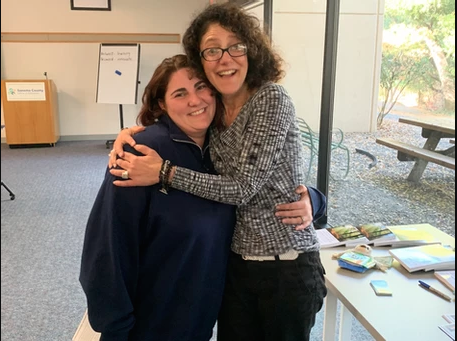Getting Beneath the Iceberg of Children’s Thoughts, Feelings, Behaviors
When you look at an iceberg you only see the part that is showing on top of the water.
We know that there is more, much more, hidden beneath the water. When caring for children who have been the victims of trauma or abuse, the base of the iceberg is more complex, more hidden or submerged. Often, it becomes basic survival for these children to hide their submerged iceberg. It may be a lack of trust, a fear of adults (who may not meet their needs), a sense of worthlessness or other inadequacies or just a desire to be invisible.
Caregivers are taxed with the job of helping children overcome their traumas to function in a challenging world and to achieve the most that they can by believing in themselves and others. But, first, caregivers need to look beneath the iceberg to decode and reprogram the beliefs and values of their child which are pushing up the behaviors and actions that we see above the water.
Let’s look at what is supporting the tip of their iceberg:
-
Thoughts, Feelings, and Behaviors
-
Fears, Needs, and Wants
-
Three Universal Questions
-
Mistaken goals
-
Chaotic, Confused, and Unsettled emotions
Thoughts, feelings and behaviors make up The Cognitive Triangle with three equal sides all connected (often used in Cognitive Behavioral Therapy). Simply explained, our thoughts affect how we feel and how we act. Our feelings (emotions) affect what we think and what we do. Our behaviors affect how we think and how we feel. If a child is made fun of, he will think less of himself, feel inadequate, feel bad enough to either withdraw, become sad, depressed or act out with negative behavior to get even. The thoughts and feelings are beneath the iceberg. When the child acts out (inappropriately) we see the behavior on top of the water – only the behavior. What pushed that behavior up is important to seek out. Just responding to the negative behavior will only be a temporary step in helping the child. We need to get beneath the iceberg.
The fears, needs and wants of a child are important to consider when trying to decode their Cognitive Triangle. A simple chart like this can help a care provider look more thoroughly at their child. What fears might he have, significant and insignificant, realistic and possibly (in our mind) unrealistic. The driving force beneath the iceberg can be the child’s wants (achievable and unachievable). The child may always fear the loss of another parent or family, he may fear rejection. One child may need more security and reassurance than another, or one may need more physical touch. Although, children may not always get their wants, it’s very important to validate their wants and provide them with a simple explanation. Explain what is achievable and available at that time.
The 3 Universal Questions are:
“I am….
“My caregiver is….
“The world is…..
If a care provider yells at a child and says, “You are so stupid, why did you do that?” ….
The child thinks and feels:
I am stupid.
My care giver is mean/not fair/cruel.
The world is a bad/uncomfortable place. And, he usually acts accordingly– withdrawing
or acting out.
However, if a care provider says, “Oh honey, do you need some help with that?”The child thinks and feels:
I am not stupid, dumb or incompetent
My care giver is willing to help.
The world isn’t so bad. Children usually act accordingly – they are willing to try.
Dr. Jane Nelsen is known for her wonderful Mistaken Goals Chart. Rudolph Dreikurs described ‘mistaken goals’ as times when children misbehave when they don’t feel a sense of belonging or being valued in life. Dr. Nelsen further explained that they are called mistaken goals, because they are based on mistaken beliefs about how to achieve belonging and significance.
-
Undue Attention – The mistaken belief: I belong only when I have your attention.
A suggested method to deal with demand of attention is by redirecting or involving the child in a useful task. Let child know you care about them and will spend time with them when appropriate.
-
Misguided Power – The mistaken belief: I belong only when I’m the boss or at least when I don’t let you be the boss of me.
To deal with a power struggle, it is suggested to start by acknowledging that you can’t force him and ask for help. Don’t fight and don’t give in. Withdraw from conflict and calm down. Be kind and firm. Act; don’t talk. Decide what you will do. Let routines be boss. Develop mutual respect. Give limited choices. Get help from child to set reasonable and few limits. Practice follow-through. Encourage. Redirect to positive power. Use family meetings.
-
Revenge – The mistaken belief: I don’t belong, but at least I can hurt you back.
A suggested method to deal with a vengeful behavior is to deal with the underlying hurt feelings. A phrase to open this conversation may be, “your behavior tells me that you must feel hurt. Can we talk about that?” Avoid punishment and retaliation. Use reflective listening. Make amends. Encourage strengths. Use family meetings.
-
Assumed Inadequacy – The mistaken belief: It is impossible to belong. I give up.
To overcome the mistaken belief of inadequacy, continue to show faith. Take small steps. Stop criticism. Encourage any positive attempt, no matter how small. Focus on assets. Don’t pity. Don’t give up. Set opportunities for success. Teach skills/show how. Enjoy the child. Build on his/her interests. Encourage, encourage, encourage. Use family meetings.
My favorite way to encourage (or motivate) a child is to acknowledge his efforts, not his achievements. “You really worked hard on that project!” By acknowledging a child’s efforts, he will develop inner confidence and self-motivation. It will also be reassuring and shows that you are interested in what he does.
Looking beneath the iceberg is a not a one and done strategy. What is happening beneath the surface often changes, and we caregivers must continue to look for our children’s unspoken thoughts, feelings and behaviors and their fears, needs and wants.
Donna Erickson, M.A. is a valued Help One Child Trainer and Podcasts and Blog contributor. Donna has trained Foster Parents for 30+ years through The Santa Clara County Department of Family and Children Services and served as the Foster and Kinship Care Education Program Director for 16 of those years. Donna stays current on her continuing education in her three fields of expertise: nursing, counseling, and educating. She brings experience and wisdom from her years as a foster youth, parent and grandparent!









